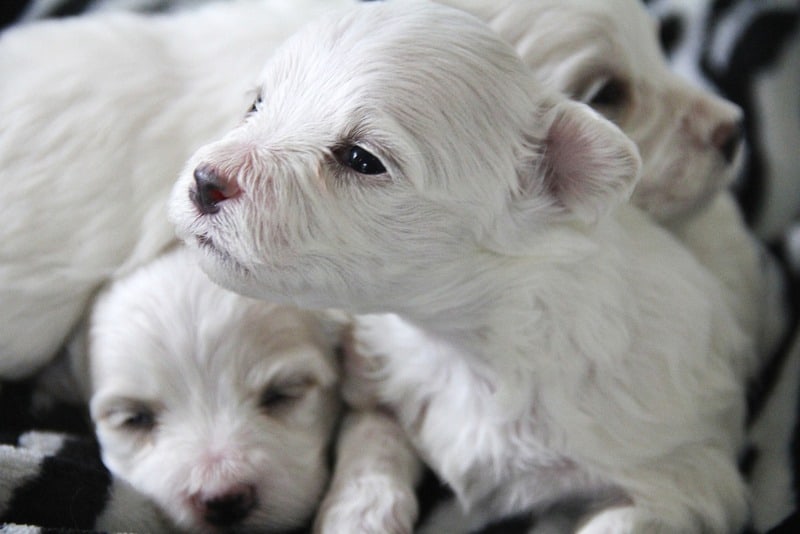What’s the Largest Litter Ever Recorded?
In 2004, a Neapolitan mastiff named Tia became the mother of the largest litter ever documented, when she delivered 24 puppies via Caesarian section.
This is obviously quite the anomaly, as most dogs produce much smaller litters than this. In fact, Neapolitan mastiff litters typically number between 6 and 10 puppies.
A few other notable cases involving huge litters include:
There are a number of different things that can influence the size of a dog’s litter, and we’ve detailed some of the most important ones below. It is difficult to empirically determine how much these various factors influence litter size, and it is likely that the various factors influence each other to some degree.
A dog’s breed is one of the most important factors influencing litter size. Simply put, larger breeds produce larger litters. That’s why Shih Tzus, Pomeranians and Chihuahuas have litters typically ranging from one to four puppies, while Cane Corsos, Great Danes, and other giant breeds often give birth to eight puppies or more.
Within a given breed, individuals with larger body sizes (in terms of build, not weight) typically give birth to larger litters. For example, a 45-pound Labrador retriever may produce a litter of only five or six puppies, while an 85-pound Lab may produce a litter of 10 or more.
While dogs typically remain fertile for their entire lives, they are most fecund during early adulthood – usually between 2 and 5 years of age. However, a dog’s first litter is generally smaller than subsequent litters.
Dogs in good health are more likely to produce larger litters, and they’re also more likely to produce healthy puppies. In fact, it is imperative that any female slated for breeding trials be in perfect health to ensure she and the puppies will survive the birthing and whelping process.
Diet likely has a strong influence on litter size. Feeding your dog a nutritious, well-balanced diet will likely yield larger litter sizes than feeding a homemade or poor-quality food.
The smaller a dog’s gene pool is, the smaller her litters will tend to be; conversely, dogs who come from more diverse backgrounds tend to have larger litters. This means that dogs from lines that have been inbred extensively will slowly develop smaller and smaller litters.
Dogs are all individuals, who vary in countless ways; sometimes, this can include litter size. This is very difficult to predict, but dogs who produce large first litters and likely to produce large second and third litters, assuming all other factors remain constant.
Note that most of these traits relate to the dam (female) rather than the sire (male). However, the sire does have some influence on the litter size. His health, age, and individual genetic makeup will partially determine the size of the litter he sires.

7 Factors That Determine a Dog’s Litter Size
Various factors will determine how many pups are in a litter. Some aspects are genetically predetermined, while others have more to do with lifestyle and health.
How Many Litters Can a Dog Produce in a Year?
Some females can produce multiple litters within a 12-month period. It just depends on the dog’s natural cycle, body condition and the desires of the breeder. A handful of canines will cycle three or four times a year, but most dogs only have two cycles per year, spaced about six months apart.
But, breeding a female twice in the same year is frowned upon by many breeders. Doing so is very hard on the mom’s body, and many believe that it will result in a decline in the total number of puppies produced by a dog over her lifetime. Accordingly, many will allow their dog to produce a litter, and then give her a breather during her next heat cycle. This essentially means that they’ll produce one litter per year.
However, other breeders see no reason to avoid breeding dogs in heat, as long as they are healthy and in good physical condition.
In fact, breeders of this mindset often argue that because fertility decreases with age and most dogs will be six months older with every heat cycle, you can produce more puppies over the course of a female’s life by breeding in back-to-back heat cycles during the prime reproductive years of a dog’s life.
While dogs can produce quite a few litters over the course of their lives, it’s important to realize that each pregnancy takes a toll on a dog’s health. Accordingly, many conscientious breeders will only allow a given mom to produce a handful of litters.
Some breed registries may even reject registration applications if the mother has already produced too many litters. For example, The Kennel Club (the UK’s version of the AKC) may decline to register puppies produced by a mother who’s already produced four litters.